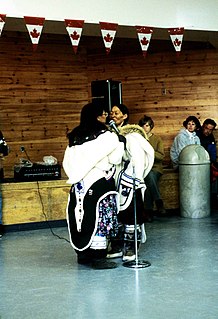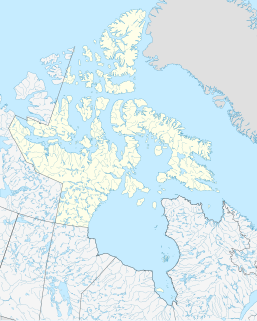Related Research Articles

Inuit throat singing, or katajjaq, is a distinct type of throat singing uniquely found among the Inuit. It is a form of musical performance, traditionally consisting of two women who sing duets in a close face-to-face formation with no instrumental accompaniment, in an entertaining contest to see who can outlast the other; however, one of the genre's most famous practitioners, Tanya Tagaq, performs as a solo artist. Several groups, including Tudjaat, The Jerry Cans, Quantum Tangle and Silla + Rise, also now blend traditional throat singing with mainstream musical genres such as pop, folk, rock and dance music.

Inuit religion is the shared spiritual beliefs and practices of the Inuit, an indigenous people from Alaska, Canada, and Greenland. Their religion shares many similarities with some Alaska Native religions. Traditional Inuit religious practices include animism and shamanism, in which spiritual healers mediate with spirits. Today many Inuit follow Christianity, but traditional Inuit spirituality continues as part of a living, oral tradition and part of contemporary Inuit society. Inuit who balance indigenous and Christian theology practice religious syncretism.

Igloolik is an Inuit hamlet in Foxe Basin, Qikiqtaaluk Region in Nunavut, northern Canada. Because its location on Igloolik Island is close to Melville Peninsula, it is often mistakenly thought to be on the peninsula. The name "Igloolik" means "there is a house here". It derives from iglu, meaning house or building, and refers to the sod houses that were originally in the area, not to snow igloos. In Inuktitut the residents are called Iglulingmiut.

Inuktitut, also Eastern Canadian Inuktitut, is one of the principal Inuit languages of Canada. It is spoken in all areas north of the tree line, including parts of the provinces of Newfoundland and Labrador, Quebec, to some extent in northeastern Manitoba as well as the Northwest Territories and Nunavut. It is one of the aboriginal languages written with Canadian Aboriginal syllabics.

The Inuit angakkuq Inuvialuktun: angatkuq; Greenlandic: angakkoq, pl.angákut) is an intellectual and spiritual figure in Inuit culture who corresponds to a medicine man. Other cultures, including Alaska Natives, have traditionally had similar spiritual mediators, although the Alaska Native religion has many forms and variants.

Atanarjuat: The Fast Runner is a 2001 Canadian epic film directed by Inuit filmmaker Zacharias Kunuk and produced by his company Isuma Igloolik Productions. It was the first feature film ever to be written, directed and acted entirely in the Inuktitut language.
Zacharias Kunuk is a Canadian Inuk producer and director most notable for his film Atanarjuat: The Fast Runner, the first Canadian dramatic feature film produced entirely in Inuktitut. He is the president and co-founder with Paul Qulitalik, Paul Apak Angilirq, and the only non-Inuit, ex-New Yorker team member, Norman Cohn, of Igloolik Isuma Productions, Canada's first independent Inuit production company. Atanarjuat: The Fast Runner (2001), the first feature film that was entirely in Inuktitut was named as the greatest Canadian film of all time by the 2015 Toronto International Film Festival poll.

Nunavut is the largest and northernmost territory of Canada. It was separated officially from the Northwest Territories on April 1, 1999, via the Nunavut Act and the Nunavut Land Claims Agreement Act, which provided this territory to the Inuit for independent government. The boundaries had been drawn in 1993. The creation of Nunavut resulted in the first major change to Canada's political map since the province of Newfoundland was admitted in 1949.

Isuma is an artist collective and Canada's first Inuit-owned (75%) production company, co-founded by Zacharias Kunuk, Paul Apak Angilirq and Norman Cohn in Igloolik, Nunavut in 1990. Known internationally for its award-winning film, Atanarjuat: The Fast Runner, the first feature film ever to be written, directed and acted entirely in the Inuktitut language, Isuma was selected to represent Canada at the 2019 Venice Biennale where they screened the film One Day in the Life of Noah Piugattuk, the first presentation of art by Inuit in the Canada Pavilion.
The Inuit Broadcasting Corporation (IBC) is a television production company based in Nunavut. Its programming is targeted at the Inuit population of Nunavut and almost all of its programs are broadcast in Inuktitut. Select programs are also broadcast in English. In contrast with traditional commercial television broadcasting companies, IBC shows centre on Inuit culture. The company has five production centres in various places in Nunavut, all staffed by Inuit. Founded in the early 1980s, the IBC was the first Native language television network in North America.
Norman Cohn is a U.S.-born Canadian film director, producer, cinematographer and editor best known for his work on films Atanarjuat: The Fast Runner and The Journals of Knud Rasmussen.
Umik was an Inuit angakkuq (shaman) who proclaimed himself a Christian evangelist and began to preach to the Igloolik Inuit in the 1920s.

Uvavnuk was an Inuk woman born in the 19th century, now considered an oral poet. The story of how she became an angakkuq, and the song that came to her, were collected by European explorers of Arctic Canada in the early 1920s. Her shamanistic poem-song, best known as "Earth and the Great Weather". has been anthologised many times.
Artcirq is an Inuit circus performance collective based in Igloolik, Nunavut, Canada. It was co-founded in 1998 by Guillaume Saladin and several circus artists from Montreal and youth from Igloolik, with the financial support of Igloolik Isuma Productions, Canada's first Inuit independent production company and Cirque Éloize. Its activities provide Inuit youth with a vehicle for creative expression that maintains strong links to Inuit traditions and performance styles.

Inuit Nunangat is the homeland of the Inuit in Canada. This Arctic homeland consists of four northern Canadian regions called the Inuvialuit Settlement Region, the territory Nunavut (ᓄᓇᕗᑦ), Nunavik (ᓄᓇᕕᒃ) in northern Quebec, and Nunatsiavut of Newfoundland and Labrador.

Mistake Bay is a waterway in Kivalliq Region, Nunavut, Canada. It is located in northwestern Hudson Bay by the old mining settlement and trading post of Tavani. Mistake Bay, to the south of Wilson Bay, has numerous islands and shoals. The mission Saint Francois Xavier was founded here in 1939 or 1940 by Father Dunleavy.
Sanaaq is a novel by Mitiarjuk Nappaaluk, a Canadian Inuk educator and author from the Nunavik region in northern Quebec, Canada. The English edition of the novel was published in 2014 by the University of Manitoba Press in partnership with the Avataq Cultural Institute. It was translated into English from French by Peter Frost.
Marie-Hélène Cousineau is a Canadian film director and producer. Originally from Quebec, she moved to Igloolik, Northwest Territories in 1990, where she became a co-founder of the filmmaking collective Arnait Video Productions.

Qajartalik is a petroglyph site located on the Qajartalik peninsula of Qikertaaluk Island, Nunavut, approximately 40 km southeast of Kangirsujuaq, Quebec. The site consists of over 150 carvings of faces in soapstone. It was created by the Dorset people, the culture who inhabited the Canadian eastern Arctic and Greenland beginning approximately 2,200 years ago before disappearing approximately 1,000 years ago, and who inhabited the region prior to the Thule Inuit who arrived approximately 800 years ago. It is believed to be the north most rock art site in North America and is considered to be one of a kind. The site is currently on Canada's tentative list of sites proposed for inscription on the UNESCO World Heritage List.
In Inuit culture, sipiniq refers to a person who is believed to have changed their physical sex as an infant, but whose gender is typically designated as being the same as their perceived original sex. In some ways, being sipiniq can be considered a third gender. This concept is primarily attested in areas of the Canadian Arctic, such as Igloolik and Nunavik. The Netsilik Inuit used the word kipijuituq for a similar concept.
References
- 1 2 3 Université Laval. "Bernard Saladin D'Anglure". Université Laval. Retrieved 31 January 2012.
- 1 2 3 Rioux, Christian. "L'Igloolik de Bernard Saladin d'Anglure: La vie avant soi". Le Devoir. Retrieved 31 January 2012.
- ↑ Tremblay, Marc-Adélard. "L'anthropologie en tant que discipline académique à Laval". Anthropologica. 44 (2): 295–307.
- ↑ "Northern Science Award". Aboriginal Affairs and Northern Development Canada. Archived from the original on 13 January 2012. Retrieved 31 January 2012.
- ↑ "IsumaTV". IsumaTV. Retrieved 24 February 2012.
- ↑ Saladin d'Anglure, Bernard. "Igloolik Nunavut". IsumaTV. Retrieved 20 February 2012.
- ↑ "Igloolik, Our Land". CNRS. Retrieved 19 February 2012.
- ↑ "Artcirq". Artcirq. Archived from the original on 1 November 2011. Retrieved 20 February 2012.
- ↑ "Biographical Data: Bernard Saladin d'Anglure". University of Manitoba. Archived from the original on 10 April 2014. Retrieved 23 January 2012.
- ↑ "Le roman Sanaaq: une parole venue du froid". Université Laval. Archived from the original on 4 March 2016. Retrieved 12 February 2012.
- ↑ "Détails d'une rencontre". Librairie Ombre Blanche. Retrieved 19 February 2012.